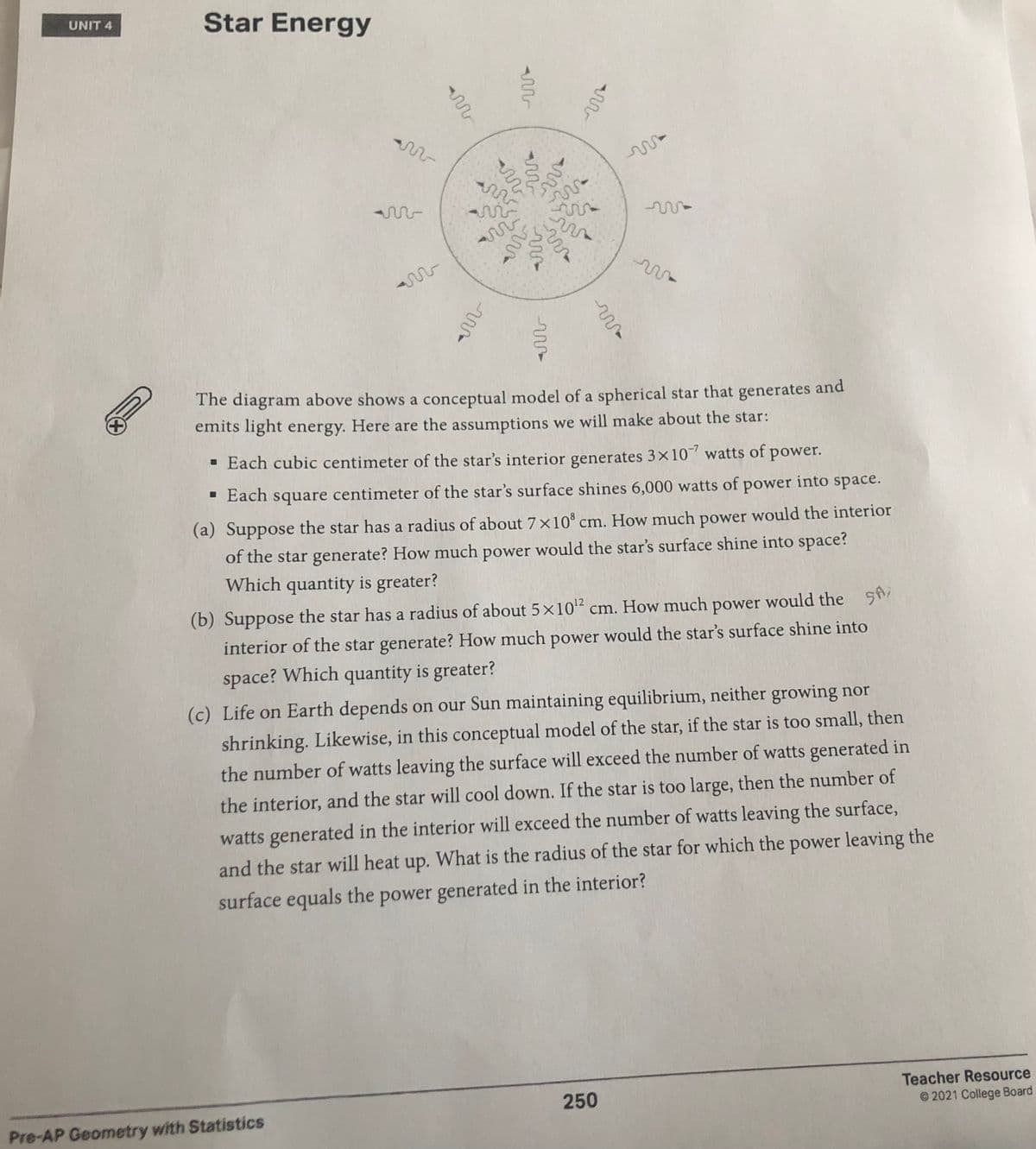225 2025 The diagram above shows a conceptual model of a spherical star that generates and emits light energy. Here are the assumptions we will make about the star: · Each cubic centimeter of the star's interior generates 3x10 watts of power. · Each square centimeter of the star's surface shines 6,000 watts of power into space. (a) Suppose the star has a radius of about 7×10 cm. How much power would the interior of the star generate? How much power would the star's surface shine into space? Which quantity is greater? (b) Suppose the star has a radius of about 5x102 cm. How much power would the interior of the star generate? How much power would the star's surface shine into space? Which quantity is greater? (c) Life on Earth depends on our Sun maintaining equilibrium, neither growing nor shrinking. Likewise, in this conceptual model of the star, if the star is too small, then the number of watts leaving the surface will exceed the number of watts generated in the interior, and the star will cool down. If the star is too large, then the number of watts generated in the interior will exceed the number of watts leaving the surface, and the star will heat up. What is the radius of the star for which the power leaving t surface equals the power generated in the interior?
225 2025 The diagram above shows a conceptual model of a spherical star that generates and emits light energy. Here are the assumptions we will make about the star: · Each cubic centimeter of the star's interior generates 3x10 watts of power. · Each square centimeter of the star's surface shines 6,000 watts of power into space. (a) Suppose the star has a radius of about 7×10 cm. How much power would the interior of the star generate? How much power would the star's surface shine into space? Which quantity is greater? (b) Suppose the star has a radius of about 5x102 cm. How much power would the interior of the star generate? How much power would the star's surface shine into space? Which quantity is greater? (c) Life on Earth depends on our Sun maintaining equilibrium, neither growing nor shrinking. Likewise, in this conceptual model of the star, if the star is too small, then the number of watts leaving the surface will exceed the number of watts generated in the interior, and the star will cool down. If the star is too large, then the number of watts generated in the interior will exceed the number of watts leaving the surface, and the star will heat up. What is the radius of the star for which the power leaving t surface equals the power generated in the interior?
Glencoe Physics: Principles and Problems, Student Edition
1st Edition
ISBN:9780078807213
Author:Paul W. Zitzewitz
Publisher:Paul W. Zitzewitz
Chapter16: Fundamentals Of Light
Section: Chapter Questions
Problem 39A
Related questions
Question

Transcribed Image Text:Star Energy
UNIT 4
The diagram above shows a conceptual model of a spherical star that generates and
emits light energy. Here are the assumptions we will make about the star:
· Each cubic centimeter of the star's interior generates 3x10 watts of power.
· Each square centimeter of the star's surface shines 6,000 watts of power into space.
(a) Suppose the star has a radius of about 7×10° cm. How much power would the interior
of the star generate? How much power would the star's surface shine into space?
Which quantity is greater?
(b) Suppose the star has a radius of about 5×10" cm. How much power would the
interior of the star generate? How much power would the star's surface shine into
space? Which quantity is greater?
(c) Life on Earth depends on our Sun maintaining equilibrium, neither growing nor
shrinking. Likewise, in this conceptual model of the star, if the star is too small, then
the number of watts leaving the surface will exceed the number of watts generated in
the interior, and the star will cool down. If the star is too large, then the number of
watts generated in the interior will exceed the number of watts leaving the surface,
and the star will heat up. What is the radius of the star for which the power leaving the
surface equals the power generated in the interior?
Teacher Resource
©2021 College Board
250
Pre-AP Geometry with Statistics
Expert Solution
This question has been solved!
Explore an expertly crafted, step-by-step solution for a thorough understanding of key concepts.
This is a popular solution!
Trending now
This is a popular solution!
Step by step
Solved in 3 steps

Follow-up Questions
Read through expert solutions to related follow-up questions below.
Knowledge Booster
Learn more about
Need a deep-dive on the concept behind this application? Look no further. Learn more about this topic, physics and related others by exploring similar questions and additional content below.Recommended textbooks for you

Glencoe Physics: Principles and Problems, Student…
Physics
ISBN:
9780078807213
Author:
Paul W. Zitzewitz
Publisher:
Glencoe/McGraw-Hill

Stars and Galaxies (MindTap Course List)
Physics
ISBN:
9781337399944
Author:
Michael A. Seeds
Publisher:
Cengage Learning

Foundations of Astronomy (MindTap Course List)
Physics
ISBN:
9781337399920
Author:
Michael A. Seeds, Dana Backman
Publisher:
Cengage Learning

Glencoe Physics: Principles and Problems, Student…
Physics
ISBN:
9780078807213
Author:
Paul W. Zitzewitz
Publisher:
Glencoe/McGraw-Hill

Stars and Galaxies (MindTap Course List)
Physics
ISBN:
9781337399944
Author:
Michael A. Seeds
Publisher:
Cengage Learning

Foundations of Astronomy (MindTap Course List)
Physics
ISBN:
9781337399920
Author:
Michael A. Seeds, Dana Backman
Publisher:
Cengage Learning

Astronomy
Physics
ISBN:
9781938168284
Author:
Andrew Fraknoi; David Morrison; Sidney C. Wolff
Publisher:
OpenStax